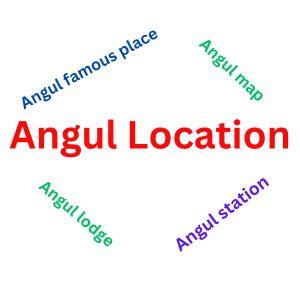Nestled in the heart of Odisha, Angul Location is a district that seamlessly blends historical richness with modern vibrancy. Known for its strategic location, economic significance, and cultural diversity.
Angul offers a unique glimpse into both traditional and contemporary Odisha. This comprehensive guide delves into various aspects of Angul’s location, providing valuable insights into what makes this district a noteworthy destination.
Geographical Overview of Angul Location
Angul is centrally situated in Odisha, bordered by the districts of Dhenkanal, Cuttack, Sambalpur, and Keonjhar. Its central location makes it a pivotal hub within the state, facilitating connectivity between major towns and cities.
The district’s geography is characterized by diverse landscapes, including rolling hills, lush forests, and scenic rivers. The Brahmani and Mahanadi rivers flow through Angul, adding to its natural charm and ecological significance.
Historical Background
Angul boasts a rich historical tapestry that reflects its significance through the ages. Historically, the region has been a melting pot of various cultures and dynasties. The ancient temples scattered across the district serve as a testament to its historical depth.
Notable among these is the Angul Fort, a relic from the past that stands as a symbol of the district’s architectural heritage and historical importance. The fort and other historical sites offer a fascinating glimpse into Angul’s storied past.
Key Areas and Localities of Angul Location
Angul district is comprised of several key localities, each with its own distinct characteristics:
- Angul Town: The administrative and commercial center of the district, Angul Town is a bustling hub that hosts various government offices, markets, and residential areas. It serves as the gateway to the rest of the district.
- Talcher: Renowned for its coal mining activities, Talcher is an industrial hotspot that plays a significant role in the district’s economy. The presence of major industries and power plants makes Talcher a crucial economic zone.
- Banarpal: A town with historical relevance, Banarpal is known for its cultural heritage and local attractions. It provides a more serene environment compared to the bustling Angul Town.
Transportation and Accessibility
Angul’s strategic location ensures excellent connectivity through various transportation modes:
- By Road: Angul has National Highways and state highways, making it easily accessible from major cities like Bhubaneswar, Cuttack, and Sambalpur. The road network ensures smooth travel within and outside the district.
- By Rail: The Angul Railway Station is a significant junction on the East Coast Railway network, linking Angul with other major cities across India. The railway services provide a convenient mode of travel for both residents and visitors.
- By Air: The nearest major airport is in Bhubaneswar, approximately 150 kilometers from Angul. The airport offers domestic flights, connecting Angul with other parts of India and facilitating easy travel.
Within Angul, local transportation options include buses, auto-rickshaws, and taxis, ensuring efficient movement within the district.
Attractions and Points of Interest(Angul is famous for)
Angul is home to several attractions that appeal to nature enthusiasts, history buffs, and cultural explorers:
- Khandadhar Waterfall: This breathtaking waterfall is one of the highest in Odisha and offers stunning views and a serene atmosphere. It is a popular spot for nature lovers and photographers.
- Satkosia Tiger Reserve: Known for its rich biodiversity and scenic landscapes, Satkosia Tiger Reserve is a haven for wildlife enthusiasts. The reserve is home to a variety of species, including the majestic tiger, and offers opportunities for wildlife safaris and nature walks.
- Angul Fort: An architectural marvel, Angul Fort provides a glimpse into the district’s historical and cultural heritage. The fort’s well-preserved structures and historical significance make it a must-visit for history enthusiasts.
Economic and Educational Significance
Angul plays a vital role in Odisha’s economy, primarily through its industrial and mining sectors:
- Industries: The district is a major center for coal mining, with several large-scale operations in Talcher. These industries contribute significantly to the regional economy and provide employment opportunities for local residents.
- Educational Institutions: Angul is home to several educational institutions, including engineering colleges and schools. These institutions play a crucial role in fostering education and skill development in the region.
Local Culture and Lifestyle
The cultural landscape of Angul is a vibrant mix of traditional and modern influences:
- Festivals: The district celebrates various festivals with enthusiasm, including Raja, Durga Puja, and local fairs. These festivals reflect the rich cultural heritage and community spirit of Angul.
- Lifestyle: The lifestyle in Angul is a blend of traditional practices and contemporary living. The district’s cultural diversity is evident in its local cuisine, art forms, and social practices.
Conclusion
Angul is a district that offers a unique blend of historical richness, economic significance, and cultural vibrancy. Its central location in Odisha makes it a crucial hub for transportation and commerce, while its natural beauty and historical landmarks provide a captivating experience for visitors.
Whether you’re exploring its attractions, learning about its history, or experiencing its local culture, Angul is a destination that truly stands out in Odisha.
Angul Location Google map/Angul map
Search Angul locaion in Google map.
Angul Jobs: Opportunities in an Industrial Hub
Angul has transformed into an industrial powerhouse in Odisha, largely due to the establishment of major industries like coal mining, power generation, and steel manufacturing.
The district houses significant industrial projects such as the NTPC Talcher Thermal Power Station, MCL (Mahanadi Coalfields Limited), and Jindal Steel and Power Limited.
These industries offer a wide range of job opportunities for professionals and workers alike.
The major sectors for employment in Angul include:
- Power and Energy: Positions in power plants like NTPC and other thermal power projects.
- Mining and Metallurgy: Opportunities in coal mining and steel manufacturing.
- Education and Administration: Angul also has a demand for teachers, government staff, and administrative roles in local institutions.
Additionally, Angul’s growth as a commercial and transport hub has led to an increase in service sector jobs, including retail, hospitality, and transportation.
Angul Map: A Gateway to the Heart of Odisha
Angul is centrally located in the state of Odisha, making it an important connecting point between different parts of the state. The district is strategically positioned, bordered by Dhenkanal to the north, Nayagarh to the south, and Keonjhar to the east.
The proximity to cities like Bhubaneswar, Cuttack, and Sambalpur further enhances its importance.
Angul is well-connected by road and rail, and with the development of the Angul-Talcher Road, access to nearby areas has significantly improved. The district’s map shows its proximity to major rivers like the Sankh River and its connection to famous tourist sites like Nandankanan Zoo and the Chilika Lake, which can be easily accessed from here.
Angul Railway Station: A Key Transit Hub
The Angul Railway Station is one of the key railway stations in Odisha and serves as an important transit point for travelers heading to various destinations within the state. The station is connected by the East Coast Railway network and offers several trains to and from major cities like Bhubaneswar, Cuttack, and Kolkata.
Located on the Kolkata-Chennai Main Line, the railway station is equipped with necessary facilities like waiting rooms, food stalls, and ticketing counters. Its strategic location ensures smooth transport for both locals and tourists, making it a vital part of Angul’s connectivity.
Angul Lodges: Comfortable Stay Options
Angul, with its growing industrial and tourist interest, offers a variety of accommodation options for visitors. Whether you’re in Angul for business or leisure, you can find hotels and lodges that suit your needs.
Some popular choices include:
- Hotel Pragati Residency: Known for its quality service and centrally located within the city.
- Sai Lodge: Offers budget accommodation with essential amenities.
- Panchavati Lodge: Another economical option for travelers, with a comfortable stay.
- Rest House, NTPC Talcher: This is a premium option for visitors associated with NTPC and its employees.
For those looking to stay near natural attractions, there are several guest houses and resorts located on the outskirts of Angul that offer a more relaxed and scenic environment.
Famous Places in Angul: A Blend of Nature and Culture
Angul may not be as widely known as some other parts of Odisha, but it is home to several famous places that attract tourists from all over. Here are some must-visit sites of Odisha.
- Tikarpada: A beautiful spot located near the Mahanadi River, Tikarpada is known for its lush green surroundings, waterfalls, and the Satkosia Gorge Sanctuary. It’s a great destination for nature lovers, adventure seekers, and birdwatchers.
- Nandankanan Zoological Park: Situated near Bhubaneswar, Nandankanan is a renowned zoo and botanical garden, home to various species of flora and fauna. It is famous for its white tigers and other wildlife.
- Chilika Lake: Although not directly in Angul, Chilika Lake is easily accessible from the district. It is Asia’s largest coastal lagoon and a hotspot for migratory birds, especially during the winter season. It is also popular for boat rides and fishing.
- Parsurameswar Temple: Located near the town of Angul, this ancient temple dedicated to Lord Shiva is a popular pilgrimage site for locals. Its historical significance and spiritual ambiance make it a major attraction for those visiting Angul.
- Hanuman Vatika: A temple complex dedicated to Lord Hanuman, this site is famous for its large statue and peaceful surroundings. It’s an ideal place for spiritual seekers.
- Ananta Vasudev Temple: This historical temple is one of the prominent religious sites in the region, attracting devotees from nearby areas.
Angul population 2024
1.5 million.
For the most accurate and up-to-date population figures, you can refer to recent data from the Census of India or local government publications.
Angul block list
- Angul Block
- Banarpal Block
- Chhendipada Block
- Dera Block
- Kaniha Block
- Pallahara Block
- Talcher Block
- Mohana Block
Angul block village list
1. Angul Block
- Angul Town
- Ranjangaon
- Ganjipalli
- Jharanapada
- Kalikaprasad
- Daspur
- Jharbandh
- Joranda
- Chhendipada
- Khamar
2. Banarpal Block
- Banarpal
- Chhendipada
- Gunduribadi
- Kankadahada
- Khairasole
- Mangalpur
- Pachapalli
- Saradhapur
- Sambalpur
3. Chhendipada Block
- Chhendipada
- Ankushpur
- Bansapal
- Daspalla
- Doudpada
- Gandapada
- Ladapada
- Nisibari
- Puhundi
4. Dera Block
- Dera
- Arda
- Baghpatna
- Haldia
- Kandhara
- Ladugaon
- Rangamatia
- Ruchapada
- Sundarapur
5. Kaniha Block
- Kaniha
- Angul
- Basantpur
- Chhendipada
- Narapada
- Nimma
- Raipada
- Sarisua
- Tikarapada
6. Pallahara Block
- Pallahara
- Amdapada
- Barpalli
- Chandapur
- Jampali
- Kandhar
- Kuliari
- Lanjira
- Rajabasa
7. Talcher Block
- Talcher
- Ankushpur
- Chhendipada
- Kalimati
- Kanaka
- Lingarajpur
- Mandalapada
- Sundara
- Tikarapada
8. Mohana Block
- Mohana
- Amba
- Chandapur
- Jalarampur
- Kalimati
- Kendupada
- Nimakhandi
- Suar
- Tikarapada
For all Village and pin code list –visit here.
FAQs
Q1: What are the main attractions in Angul?
A1: Angul’s key attractions include Khandadhar Waterfall, Satkosia Tiger Reserve, and Angul Fort.
Q2: How can I reach Angul from Bhubaneswar?
A2: Reach by road (approximately 150 kilometers) or by train from Bhubaneswar Railway Station.
Q3: What is the economic significance of Angul?
A3: Angul is significant for its coal mining and industrial activities, contributing substantially to the regional economy.
- Angul ,
- Balangir ,
- Balasore ,
- Bargarh,
- Bhadrak ,
- Boudh ,
- Cuttack ,
- Deogarh ,
- Dhenkanal ,
- Gajapati ,
- Ganjam ,
- Jagatsinghpur ,
- Jajpur ,
- Jharsuguda ,
- Kalahandi ,
- Kandhamal ,
- Kendrapada ,
- Kendujhar ,
- Khorda ,
- Koraput ,
- Malkangiri ,
- Mayurbhanj ,
- Nabarangpur ,
- Nayagarh ,
- Nuapada ,
- Puri ,
- Rayagada ,
- Sambalpur ,
- Sonepur ,
- Sundergarh


